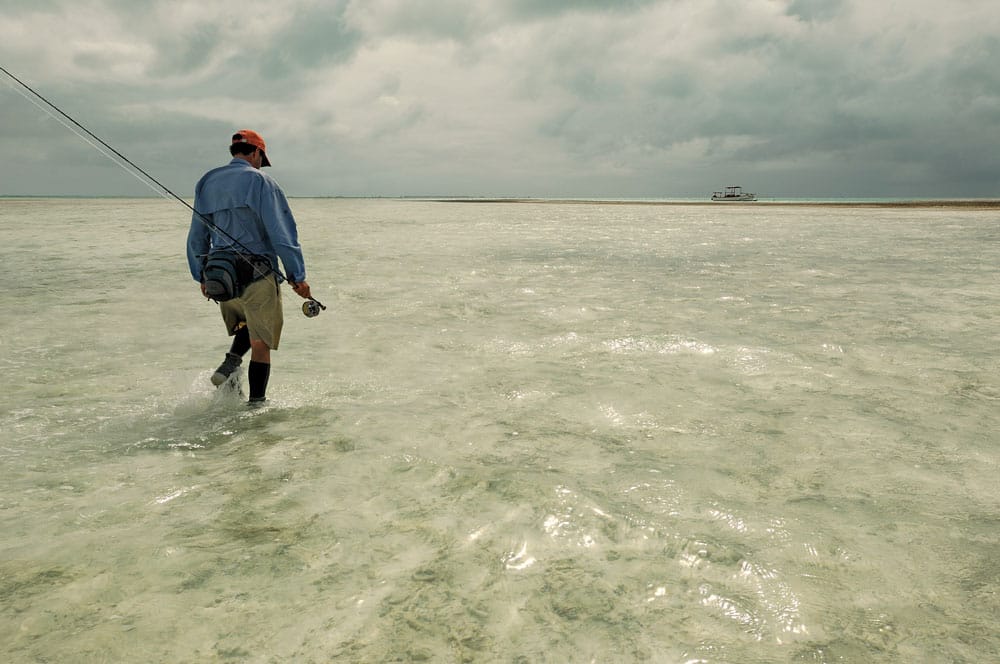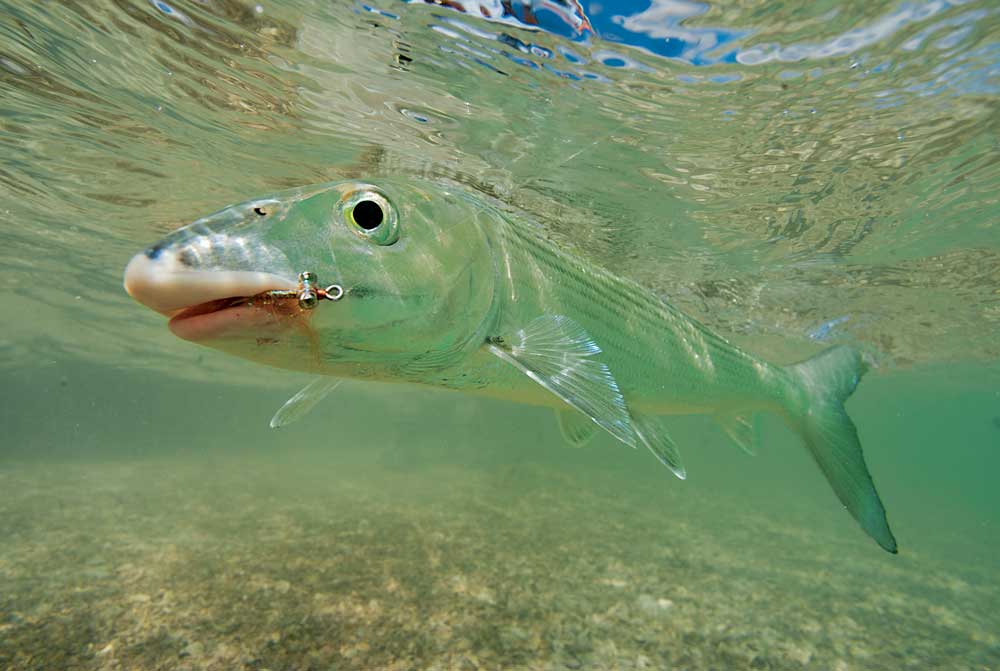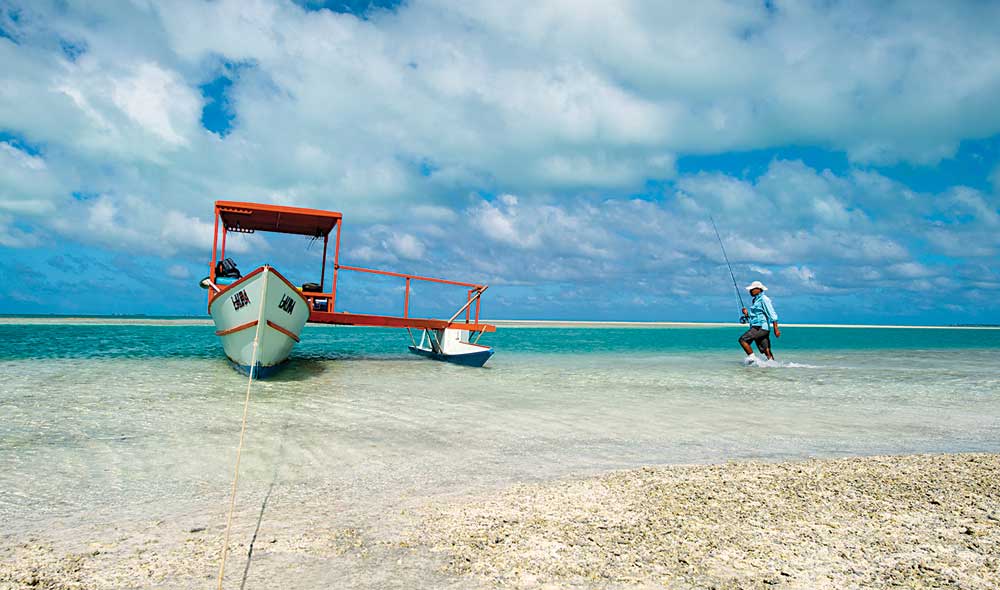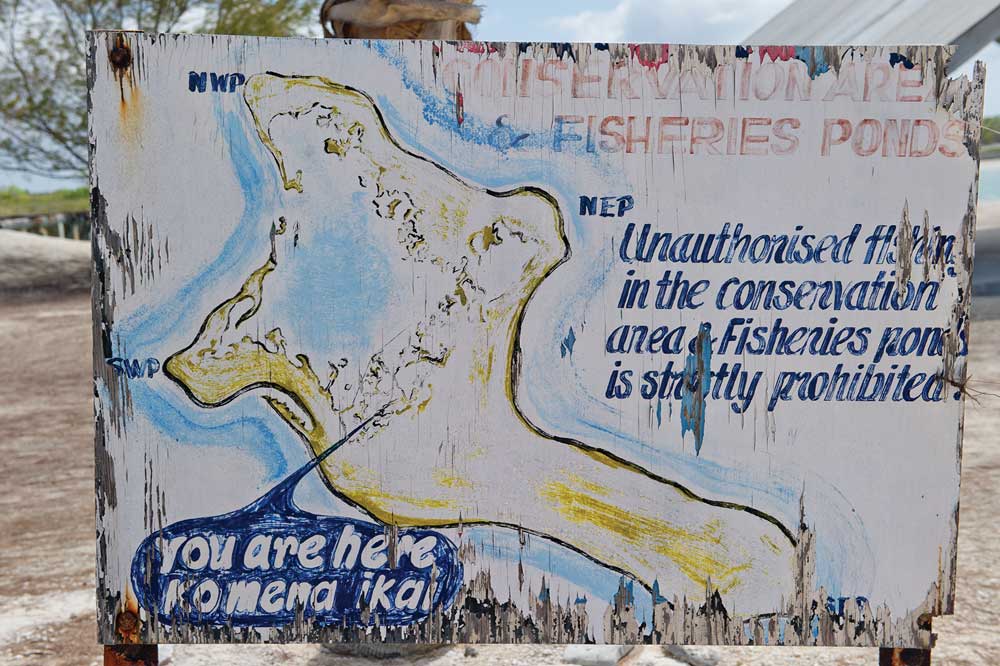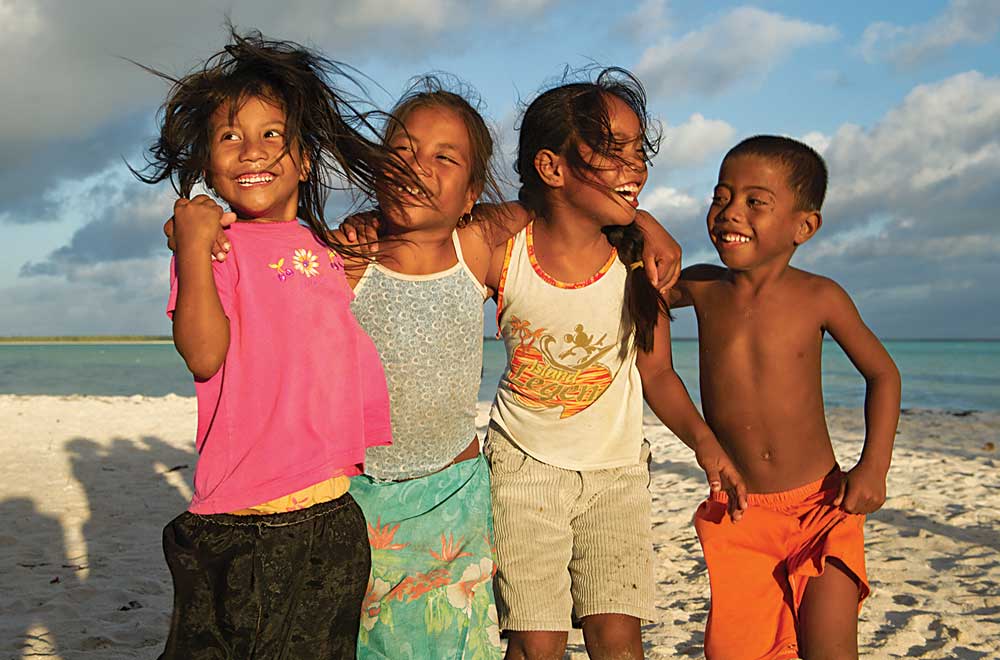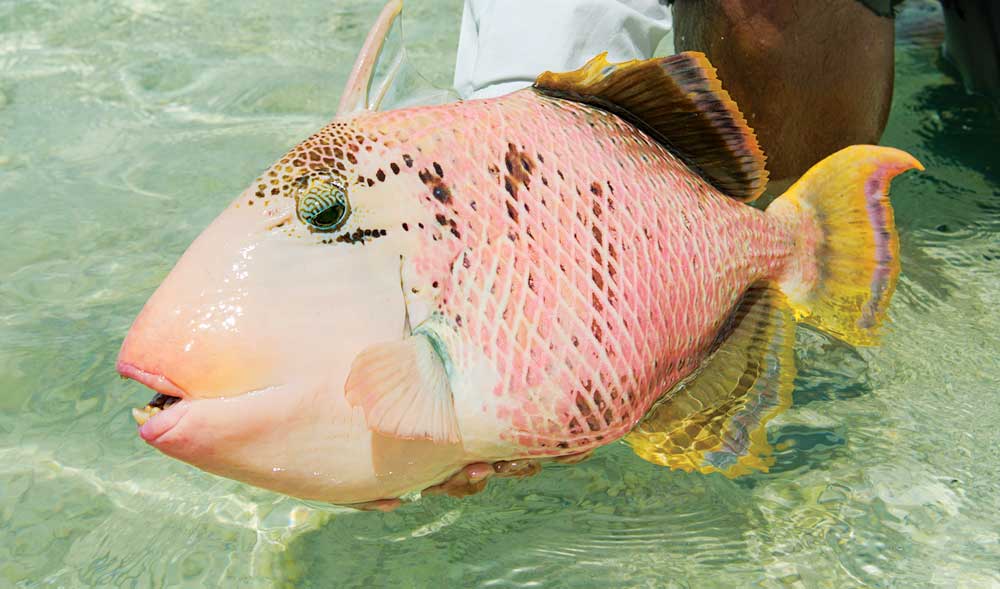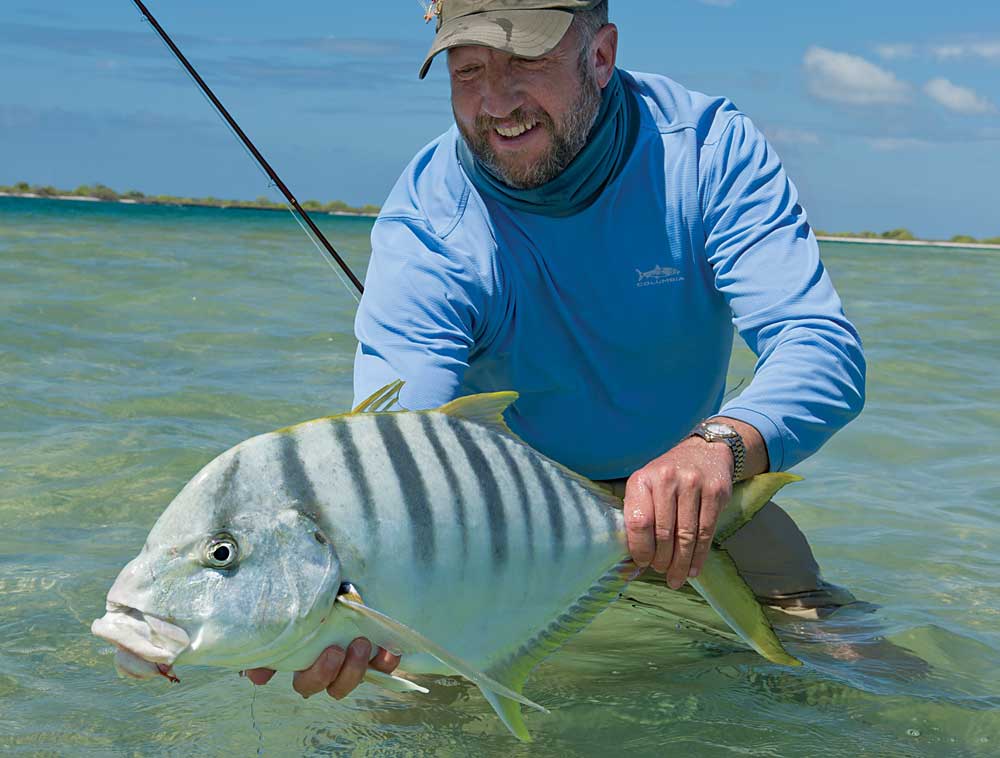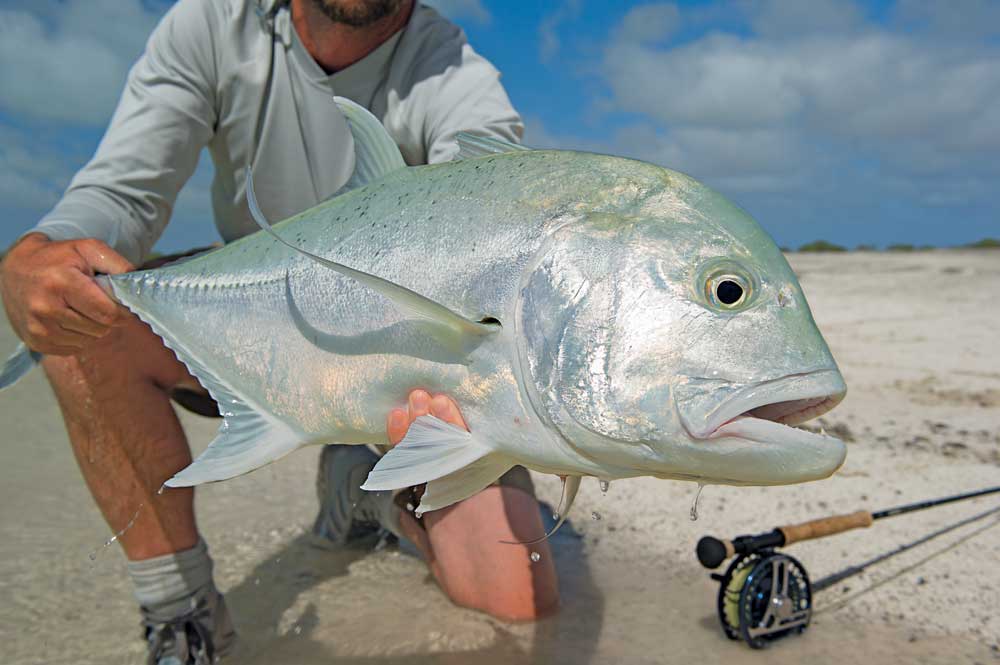
Standing on top of a pancake flat in the middle of Christmas Island’s massive lagoon, I was literally a trout fisherman at sea. An hour earlier, I’d never even heard of a pancake flat, and here I was the king of one. As my guide pulled away with my wife, I assured him that I’d be fine and was a proficient enough angler to figure things out on my own — but the truth was I didn’t have a clue what I was doing.
I paced in circles for an hour and then stood on the edge of the flat, peering into the dark blue water in front of me. Suddenly, I remembered a fly a buddy gave me that I’d never heard of — it was a Lefty’s Deceiver, a fly that my friend claimed was insanely good. So I tied on the unfamiliar pattern using the saltwater knot I’d learned only hours before.
What ensued is still a blur, and actually quite embarrassing, but it needs to be told.
I picked up my head, and in an instant, I was face to fin with a swimming garbage can. I wish I could say that I remained calm and cool, but if I did, I’d be lying. Instead, I screamed like a girl, swung my fly rod at the aquatic beast and raced for safety in the center of my pancake kingdom.
Life-Changing
As the jet made its final approach to Christmas Island last February, I was telling some first-timers about that face-to-fin introduction to giant trevally 17 years earlier. I know the term life-changing is overused these days, but that first experience did indeed change my life — and not necessarily for the better.
After that initial trip to Christmas Island, a territory of Australia, I became crazed with everything salt water. Gone were the days of trout exploration across Montana, Oregon and Idaho. All I could think about was giant trevally and what else I had been missing for all these years. I obsessed over Bimini twists and Huffnagle and Albright knots until I could tie them blindfolded. My travel cases were now filled with 12-weight fly rods, and my 5-weight rods were pushed farther and farther back in the closet.
Over the years, I have heard it all concerning the downfall of Christmas Island’s flats-fishing. Too many people, too many fishermen, netting and even global warming are all said to threaten the habitat and fishery. Well, I won’t argue that the fishing is as good as it was in the early 1990s, but that said, it offered some of the best fishing I’d had anywhere this past winter. The only thing I know for sure about Christmas Island is that it produces. And I mean year after year it offers the traveling angler some of the most consistent flats-fishing in the world. Just 119 miles north of the equator, it has a location ideal for great year-round weather — as long as you consider the mid-80s with a nice breeze to fit the requirements of great weather. This is not to say that the island doesn’t get rainfall, because it does, but nothing like I have experienced in other locations.
Christmas Island flats offer the absolute best of both worlds, as even less experienced saltwater anglers have countless opportunities at cruising bonefish. There isn’t a better place to sharpen your saltwater fly-fishing skills. The best way to become a better fisherman is to catch a bunch of fish. As far as I’m concerned, the guides are some of the best in the world and have eyes like eagles. With these guys at your side, you’ll hook and land your first bonefish before you realize a fish is within casting distance. With one guide per two anglers, the person who needs the help gets it, and the one who likes to fish solo can. I don’t consider myself in the same league as these guides, but like many experienced fly-anglers, I love hunting the flats on my own. Nothing beats spotting your own fish, making the cast, watching the fish eat your fly and setting the hook on the fish.
After a few days, you’ll notice that you are spotting fish easier and getting more fish to eat. The biggest problem occurs when Mr. GT shows up and you’re toting only a bonefish rod. I recommend casting anyway — it makes a great war story even if you get spooled and lose your line. That being said, make sure to pack a few extra fly lines.
More Options
It seems like most people visit Christmas Island to chase bonefish, but as one angler told me, “Bonefish brought me to Christmas Island, but giant trevally are what will bring me back!” And I get it. Few angling thrills rival hunting giant trevally on the flats, but there’s even more to look forward to. After speaking with local guides and doing a little exploring, I realized that Christmas Island has a whole different fishery within its fishery. These days I spend as much time fishing for other species as I do bonefish and giant trevally. My newest passion is stalking triggerfish, which are found on most of the flats. Pound for pound, they’re as strong as fish come, really tricky to hook properly and tough to land because you have to keep them from returning to their houses (think rocks and holes).
It’s only been the past few years that anglers have really started to focus on triggerfish. I still remember my first attempts 15 years ago and even kept a few of my mangled flies, retrieved after they were crushed by a fish’s huge teeth. The trick is to watch the fish tipping toward the fly and strip-set before the fish inhales it. Once it’s past the teeth, the game is over. But with some practice, you can learn to watch the fish and set the hook as the beast reaches the fly. If you can hook the fish in the lips, you have completed the first task. The second consists of keeping the fish from its house, which is tough but not impossible. The best thing about triggerfish is that you’ll get a lot of shots, and the guides are becoming very experienced in catching them. The flats are also home to golden trevally, striped trevally and bluefin trevally, as well as sweetlips. I could spend weeks chasing these species and never even cast to a bonefish.
Also overlooked is the offshore fishing the island offers. It’s the most consistent blue-water fishery I have ever seen. Recently one of the lodges brought in fiberglass center-console boats, which in my mind is a real game changer. They’re more comfortable and maneuverable, plus they’re faster, safer and fly-fishing friendly. This past winter, we were able to get the boats into areas I never thought possible, which allowed us to fish places in the lagoon that rarely get any action. We whipped giant trevally in the mornings and looked for wahoo and tuna in the afternoons.
The only problem with the offshore fishing is having enough tackle. Because these fish are big and bad and do not offer mercy, anglers can end up losing lots of gear.
All the Conveniences of Home
Because of Christmas Island’s remote location, supplies are always an issue. The odd cargo ship arrives frequently enough to keep the island stocked with staple products like rice, but fresh meat, fruits and vegetables are all flown in at a huge expense. And it is not uncommon for deliveries to get bumped because of priority air shipments. These days, there is a reputable airline that comes to the island once a week. The vast majority of traveling anglers will not experience any issues whatsoever with having fresh food to eat while on the island. The lodges have also gotten better over time, and now anglers can stay in clean and well-maintained operations. After a day on the flats, an air-conditioned room, a nice shower, a cold beer and a soft bed are more than welcome.
Going Native
Although I have never figured out exactly how much time I’ve spent on the island, I am sure it’s well over 50 weeks since first visiting in the mid-1990s. At one point I was running around the island shoeless most of the time, which means I was probably drinking too many Victoria Bitters and had lost my flip-flops. My feet had gone island, and me along with them. I was also spending so much time with some of the more colorful characters on the island that I began to feel I was part of their inner circle. I realized I wouldn’t really be able to understand their culture unless I spent much more time on the island. In the meantime, my plan has been to keep my wits about me, have a few warm Victoria Bitters handy and never lose my sense of humor.
My saltwater addiction has taken me all over the world, and I have fished for blue marlin, striped marlin, yellowfin tuna, sailfish, tarpon, permit, roosterfish and a bunch of other great fish, but if I had one trip left in me, I’d be headed straight back to Christmas Island.
Planning Your Christmas Island Experience
Having fly-fished all over the globe, I can say this is a one-of-a-kind and very special destination. Here’s some recommended gear to bring with you.
Wading — Virtually all the flats at Christmas are wadable and the tides are relatively small. There may be the rare opportunity to fish the edge of a flat for trevally or other species out of the boat, but all bonefishing is done on foot. When your feet are done, you are done. For boots, don’t skimp — they should be comfortable and rugged.
Rods, Reels and Lines — For bonefish and other species like golden trevally, triggerfish and sweetlips, a 7- or 8-weight rod is best. When choosing a reel, think of the larger fish and species and not the schoolie bones. Use a large-arbor reel with a bombproof drag with 30-pound backing. Floating will cover you for most situations.
For trevally, a 10- to 12-weight rod is the right tool. If you are targeting trophy GTs, fish over 40 to 50 pounds, use a 12-weight. A sturdy reel with a substantial drag system is a must. Load it with a floating or intermediate-tip line. Use a shock leader of 80-pound-test fluorocarbon.
Flies — Christmas Island Specials in orange, pink, yellow and pearl; tan Charlies; Rabbit Charlies; Gotchas; Veverka’s Mantis Shrimp and other small shrimp variations work great. Fly sizes should range from 4 to 8.
Trevally flies — Sea Habit Bucktails in assorted colors; Deceivers in tan-and-white, olive-and-white and red-and-yellow; poppers; gurgler patterns. Use sizes 1/0 to 4/0. Poppers are great attractors but hard to hook fish on unless they are really hungry.
Accommodations — The Ikari House is the newest lodge on the island and is where I stayed in February 2012. The warm hospitality of owner Jacob Teem and his skilled staff made for a memorable time. Long days on the water with tenacious guides resulted in new fishing experiences. Five bedrooms, each with a private bath, on-demand hot water (that really works!) and thermostatic-controlled air conditioning.
Food — The meals are really something to look forward to. Most dinners have two entrees and are served family style. Breakfast is made to order, as are lunches.
Bar — The lodge has cold beer, soft drinks and water. If you would like mixed drinks, bring your own liquor.
Getting there — There is a once-a-week flight with Air Pacific on a 737 from Honolulu that departs at noon on Tuesday and arrives back in Honolulu at 10:30 a.m. the following Tuesday. This requires an overnight in Honolulu on the way in, but not on the way home.
Fishing — The time of departure for fishing depends on the tides. The guides on Christmas Island are all experienced professionals who know the island and their stuff. At this time, they have 25- and 30-foot boats that are planing-hull designs with open configurations. In addition, they have a traditional island outrigger.
Booking Agents
Fish Head Expeditions: 503-539-1451; fishheadexpeditions.com
Angler Adventures: 860-434-9624; angleradventures.com
Angling Destinations: 800-211-8530; anglingdestinations.com
The Fly Shop: 800-669-3474; flyshop.com
